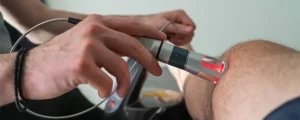PEMF Therapy
PEMF therapy, or Pulsed Electromagnetic Field therapy, is a non-invasive treatment that utilizes electromagnetic fields to promote healing and wellness in the body. The therapy works by delivering low-frequency electromagnetic waves that penetrate tissues and cells, stimulating cellular function and encouraging natural healing processes.
The Science Behind PEMF Therapy and Its Impact on Chronic Back Pain
PEMF (Pulsed Electromagnetic Field) therapy is an innovative treatment modality that has garnered attention for its potential in alleviating chronic back pain. At its core, PEMF therapy involves the use of electromagnetic fields to stimulate cellular function and promote healing. The science behind this therapy is rooted in the understanding that every cell in our body generates a tiny electrical charge, which is essential for maintaining optimal health.
When applied, PEMF devices emit low-frequency electromagnetic waves that penetrate tissues and influence cellular activity. This stimulation can enhance blood circulation, reduce inflammation, and facilitate the repair of damaged tissues—all critical factors in managing chronic back pain. Research has shown that these electromagnetic fields can improve oxygen delivery to cells and promote the elimination of toxins, thereby supporting overall recovery.
Furthermore, PEMF therapy has been linked to pain relief through its effects on nerve signaling. By modulating the electrical activity within nerves, it can help decrease pain perception and improve mobility for those suffering from persistent back issues.
Key Benefits of Using PEMF Therapy for Chronic Back Pain Relief
Reduced Inflammation: One of the primary benefits of PEMF therapy is its ability to reduce inflammation in the body, which can be a significant contributor to chronic back pain.
Enhanced Circulation: By improving blood circulation, PEMF therapy helps deliver essential nutrients and oxygen to damaged tissues in the back, promoting healing and recovery.
Improved Sleep Quality: Chronic pain often disrupts sleep patterns; however, by alleviating discomfort, PEMF therapy can lead to better sleep quality and overall well-being.
Muscle Relaxation: The electromagnetic fields used in PEMF therapy help relax muscles around the spine, reducing tension and stiffness that contribute to back pain.
Supports Cellular Repair: PEMF therapy stimulates cellular repair processes within the body, aiding in recovery from injuries or conditions that may cause chronic back pain.
Holistic Approach: This therapy aligns with holistic health principles by addressing not just the symptoms but also promoting overall wellness through natural means.
Incorporating PEMF therapy into your treatment plan may offer numerous benefits for managing chronic back pain effectively and safely.
Comparing PEMF Therapy with Other Treatment Options for Chronic Back Pain
When it comes to managing chronic back pain, various treatment options are available, each with its own set of benefits and limitations. Among these, Pulsed Electromagnetic Field (PEMF) therapy has gained attention for its non-invasive approach and potential effectiveness.
Traditional treatments for chronic back pain often include medications such as NSAIDs or opioids, physical therapy, and even surgical interventions. While these methods can provide relief for some patients, they may also carry risks of side effects or complications. Medications can lead to dependency or gastrointestinal issues, while surgery may involve long recovery times and potential complications.
In contrast, PEMF therapy utilizes low-frequency electromagnetic fields to stimulate cellular repair and reduce inflammation. This method is non-invasive and generally well-tolerated by patients. Unlike pharmaceuticals that mask pain symptoms without addressing the underlying issues, PEMF therapy aims to promote healing at the cellular level.
In summary, when comparing PEMF therapy with other treatment options for chronic back pain, it stands out due to its non-invasive nature and focus on promoting natural healing processes. As always, individuals should consult with healthcare professionals to determine the most appropriate treatment plan tailored to their specific needs.







